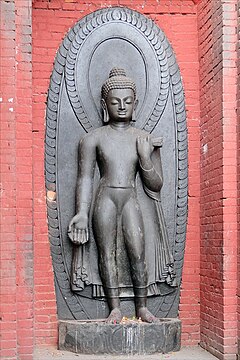Dipankara
This article needs additional citations for verification. (September 2007) |
| Dipankara Buddha | |
|---|---|
 7th century statue in a niche of Swayambhunath, Kathmandu
The great stupa is surrounded by numerous monuments, secondary stupas and religious sculptures. | |
Śaraṇaṃkara Buddha | |
Dipankara (
Generally, Buddhists believe that there has been a succession of many Buddhas in the distant past and that many more will appear in the future. Dipankara was one of these previous Buddhas, while Gautama Buddha was the current and most recent Enlightened one, and Maitreya will be the next Buddha in the distant future.
Chinese Buddhism honors Dipankara as one of many Buddhas of the past. Dipankara, Gautama, and Maitreya are "the Buddhas of Three Times" in Yiguandao.
Iconography

Dipankara is generally represented as a sitting Buddha, but his depictions as a standing Buddha are common in China, Thailand, and Nepal; with the right hand he generally forms a protection mudra (abhaya mudra), and often he forms it with both hands.
Dipankara is rarely depicted alone; He is generally depicted with two
); or with the Buddhas who come after him, Gautama and Maitreya.One of the Buddhas of Bamiyan, destroyed by the Taliban government in Afghanistan in 2001, was said to portray Dipankara. Statues of Dipankara can also be found in the Longmen and Yungang Grottoes in China.
Prediction
One story shown in Buddhist art has Gautama Buddha in a former incarnation known as Sumedha, a rich Brahmana turned hermit kneeling and laying his long black hair on the ground, in an act of piety that the Dipankara Buddha could cross a puddle of mud without soiling his feet.[2][3]
This meeting between Dipankara and Sumedha occurred many lifetimes before Sumedha's eventual enlightenment as Gautama Buddha (Shakyamuni). From this act, Dipankara told Sumedha "In the ages of the future you will come to be a Buddha called 'Shakyamuni'",[4] to which Sumedha replied, "I am to become a Buddha, awakened to enlightenment; may you tread with your feet on my hair - on my birth, old age, and death."
Dipankara then said, "Freed from human existence, you will become an effective teacher, for the sake of the world. Born among the
In the 40-plus years of his life after enlightenment, Gautama Buddha is said to have recounted almost 554 past life stories, (called
Veneration

By the 17th century, Dipankara had become a figure of veneration in Nepalese Buddhist communities. These followers consider him a protector of merchants and associate him with alms-giving. He is also considered the protector of sailors, and sometimes statues of Dipankara are found on the coastline to guide and protect the ships in their route.
Some Chinese folk religionists in Taiwan and Chinese overseas communities also worshipped Dipankara Buddha.
The Buddhavamsa says that Dipankara achieved Nirvana in
See also
- List of the twenty-eight Buddhas
- Randeng Daoren
- Samyak
References
- ^ World Cycles When Buddhas Appear (PDF). p. 117.
- ^ "Life of the Buddha: Dīpankara's Prediction of Enlightenment". The Huntington Archive - The Ohio State University. Archived from the original on 8 August 2014. Retrieved 16 September 2012.
- ^ Ghosh, B (1987). "Buddha Dipankara Twentyfourth Predecessor of Gautama" (PDF). Bulletin of Tibetology. 2: 33–38.
- ^ Thomas Cleary (translator) (1998). The Sutra of Hui-neng Grand Master of Zen With Hui-neng's Commentary on the Diamon Sutra (PDF). p. 126.
{{cite book}}:|author=has generic name (help) - ^ "Sanghata Sutra". Sanghata Sutra.
- ISBN 978-0691117645.
